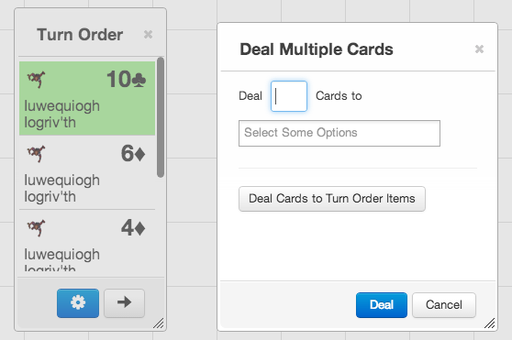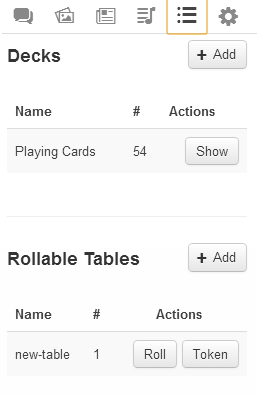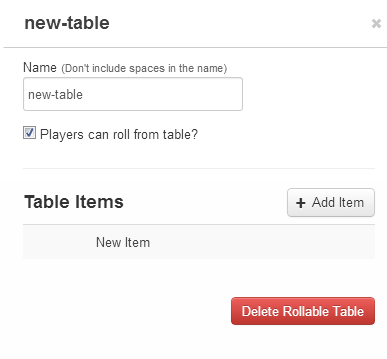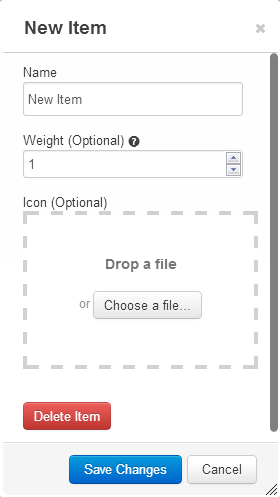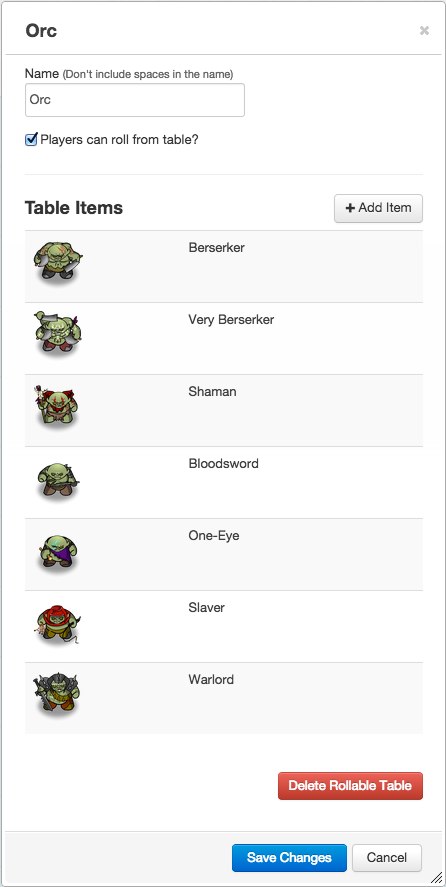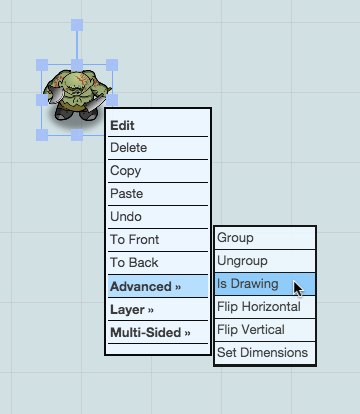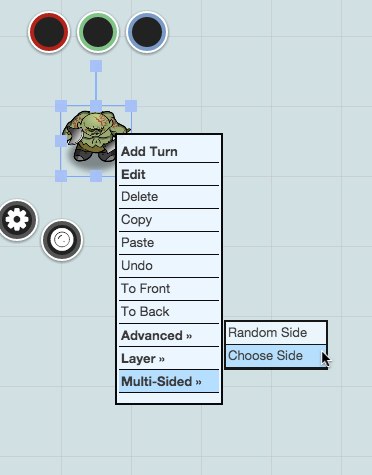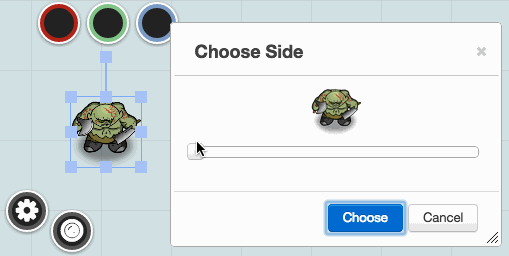Difference between revisions of "Collections"
From Roll20 Wiki
m |
Stephanie P. (Talk | contribs) |
||
| Line 15: | Line 15: | ||
| − | ===Hiding/Showing Decks=== | + | === Hiding/Showing Decks === |
By default, decks are hidden. If you want to interact with a deck, click the Show button. The deck will appear along the right-hand side of the tabletop area, and depending on the settings of the deck it will be visible to players and/or the GM. | By default, decks are hidden. If you want to interact with a deck, click the Show button. The deck will appear along the right-hand side of the tabletop area, and depending on the settings of the deck it will be visible to players and/or the GM. | ||
| − | ===Drawing | + | === Drawing Cards === |
Mouseover the deck to interact with it. The most basic action is to draw the next card from the deck, which you can do by just clicking toward the top of the deck, where the next card is "peeking out" from behind the deck. The card will be drawn and shown on top of the deck, and anyone (including players) who has permission to see the deck will also see what card was just drawn. | Mouseover the deck to interact with it. The most basic action is to draw the next card from the deck, which you can do by just clicking toward the top of the deck, where the next card is "peeking out" from behind the deck. The card will be drawn and shown on top of the deck, and anyone (including players) who has permission to see the deck will also see what card was just drawn. | ||
| − | ===Playing Cards=== | + | === Playing Cards === |
If you want to play a card from the deck to the tabletop, you can click and drag on the card you just drew (the top card on the deck, that's facing up) and drop it onto the tabletop. It will appear as a token on the tabletop that you can move and resize just like a regular token. You can also drag and drop the next card (the one you would normally click on to draw the card) directly from behind the deck onto the tabletop, and this will play the card to the table without first revealing what the card is. | If you want to play a card from the deck to the tabletop, you can click and drag on the card you just drew (the top card on the deck, that's facing up) and drop it onto the tabletop. It will appear as a token on the tabletop that you can move and resize just like a regular token. You can also drag and drop the next card (the one you would normally click on to draw the card) directly from behind the deck onto the tabletop, and this will play the card to the table without first revealing what the card is. | ||
| Line 29: | Line 29: | ||
Holding the Shift key while you drag the card onto the tabletop will play it to the tabletop face down instead of face up (which is the default). You can also right-click on an already-played card to flip it over and switch between face up or face down. | Holding the Shift key while you drag the card onto the tabletop will play it to the tabletop face down instead of face up (which is the default). You can also right-click on an already-played card to flip it over and switch between face up or face down. | ||
| − | ===Dealing Cards=== | + | === Dealing Cards === |
You can also deal cards to players. This allows players to have a collection of cards in their "hand" just like at a real tabletop. To do so, just drag a card from the back of the deck (like you would if you were playing it to the tabletop or drawing it) or the top of the deck (if the card has already been drawn), and drop the card onto the name of the player along the bottom-left side of the tabletop area. You will see a little icon of the deck appear above the player's avatar along with a number representing how many cards that player has in their hand. | You can also deal cards to players. This allows players to have a collection of cards in their "hand" just like at a real tabletop. To do so, just drag a card from the back of the deck (like you would if you were playing it to the tabletop or drawing it) or the top of the deck (if the card has already been drawn), and drop the card onto the name of the player along the bottom-left side of the tabletop area. You will see a little icon of the deck appear above the player's avatar along with a number representing how many cards that player has in their hand. | ||
| Line 39: | Line 39: | ||
If you want to take back the cards that you've dealt and played, you can click on the "Recall" button in the deck menu that appears when you mouseover the deck. You have the ability to recall cards from the tabletop, from player's hands, or just those that were discarded (drawn but never played or dealt). You can also shuffle the deck as your Recall it, which puts all the available cards back in a random order. There's also a separate Shuffle option if you just want to Shuffle the discarded cards without taking back any played or dealt cards (this will shuffle all cards which are in the "discard pile" of the deck, which includes all cards which have been deleted from the table or which were never played/dealt after being drawn). | If you want to take back the cards that you've dealt and played, you can click on the "Recall" button in the deck menu that appears when you mouseover the deck. You have the ability to recall cards from the tabletop, from player's hands, or just those that were discarded (drawn but never played or dealt). You can also shuffle the deck as your Recall it, which puts all the available cards back in a random order. There's also a separate Shuffle option if you just want to Shuffle the discarded cards without taking back any played or dealt cards (this will shuffle all cards which are in the "discard pile" of the deck, which includes all cards which have been deleted from the table or which were never played/dealt after being drawn). | ||
| − | ===Using Cards for Initiative Order=== | + | === Using Cards for Initiative Order === |
[[File:DealingInitiative.png|thumb|c|right|Dealing Cards to the Turn Order]]Some games such as ''Savage Worlds'', utilize a playing deck to manage initiative. A secondary option available from the Deal window is a button labeled "Deal Cards to Turn Order Items". If you have tokens added to the Turn Order, pressing this button will deal a card to each character there. You can also drag a single card to the turn order by turning it over atop the deck and then clicking and dragging it to a character in the turn order. *Note: you should aim for the entry area that lists the turn order number. It will highlight in yellow if you're hovering in the right place. Otherwise Roll20 assumes you're dropping the card to the tabletop instead. | [[File:DealingInitiative.png|thumb|c|right|Dealing Cards to the Turn Order]]Some games such as ''Savage Worlds'', utilize a playing deck to manage initiative. A secondary option available from the Deal window is a button labeled "Deal Cards to Turn Order Items". If you have tokens added to the Turn Order, pressing this button will deal a card to each character there. You can also drag a single card to the turn order by turning it over atop the deck and then clicking and dragging it to a character in the turn order. *Note: you should aim for the entry area that lists the turn order number. It will highlight in yellow if you're hovering in the right place. Otherwise Roll20 assumes you're dropping the card to the tabletop instead. | ||
| − | ===Using Hands=== | + | === Using Hands === |
After the players have been dealt cards and have one or more hands, they can click on the card icon above their avatar to open the hand. They can view the cards in their hand, as well as drag and drop to re-order their hand. They can also use the button at the top-right of their hand while it is open to view all the cards together or view the cards in their hand organized by deck. If they drag a card from their hand onto the tabletop, it will play the card onto the table, removing it from their hand. | After the players have been dealt cards and have one or more hands, they can click on the card icon above their avatar to open the hand. They can view the cards in their hand, as well as drag and drop to re-order their hand. They can also use the button at the top-right of their hand while it is open to view all the cards together or view the cards in their hand organized by deck. If they drag a card from their hand onto the tabletop, it will play the card onto the table, removing it from their hand. | ||
| − | ===Stealing Cards=== | + | === Stealing Cards === |
Players can also open each other's hands, and by default they will only see the back of the other player's cards. If they mouseover a card in another player's hand, they have the option to "steal" that card. A dialog box will popup for the player they are stealing from to let them confirm the action. This is useful in games where players can steal from each other's hands, without seeing the card first. | Players can also open each other's hands, and by default they will only see the back of the other player's cards. If they mouseover a card in another player's hand, they have the option to "steal" that card. A dialog box will popup for the player they are stealing from to let them confirm the action. This is useful in games where players can steal from each other's hands, without seeing the card first. | ||
| − | ===Trading Cards=== | + | === Trading Cards === |
If a player drags a card out of their hand and onto another player's name, it will initiate a trade between the two players. The players will both see a dialog box which lets them add and remove cards from the trade, and when both have confirmed the trade is acceptable it will proceed. | If a player drags a card out of their hand and onto another player's name, it will initiate a trade between the two players. The players will both see a dialog box which lets them add and remove cards from the trade, and when both have confirmed the trade is acceptable it will proceed. | ||
| − | === | + | ===A dding/Editing Decks === |
If you click on the name of the deck (in the deck listing of the My Settings tab), you'll open up a dialog box with additional options and settings: | If you click on the name of the deck (in the deck listing of the My Settings tab), you'll open up a dialog box with additional options and settings: | ||
| Line 75: | Line 75: | ||
'''Card size on tabletop''' Determines the size that the cards are played to the tabletop at. If left blank, the system will automatically determine a size. | '''Card size on tabletop''' Determines the size that the cards are played to the tabletop at. If left blank, the system will automatically determine a size. | ||
| − | ===Adding/Editing Cards=== | + | === Adding/Editing Cards === |
Underneath the deck's options you will see a listing of each card in the deck. Click the "Add" button to add a new card, or click on the name of an existing card to edit it. Doing so will bring up a dialog box with additional settings for that card, which allow you to set the card's name and upload an image for the card, as well as a button to delete the card. | Underneath the deck's options you will see a listing of each card in the deck. Click the "Add" button to add a new card, or click on the name of an existing card to edit it. Doing so will bring up a dialog box with additional settings for that card, which allow you to set the card's name and upload an image for the card, as well as a button to delete the card. | ||
| Line 83: | Line 83: | ||
'''Important Note:''' Your card faces and card back should all have the same dimensions for best results! | '''Important Note:''' Your card faces and card back should all have the same dimensions for best results! | ||
| − | == Rollable Tables== | + | == Rollable Tables == |
Revision as of 17:36, 26 August 2015
Contents |
Card Decks
Card decks in Roll20 are a collection of one or more cards that can be shuffled, drawn, dealt to players, and played onto the tabletop. You manage your game's decks under the My Settings menu.
Every game gets a deck of standard playing cards already set up and ready to go. You can also click the "Add" button next to the Decks header to create your own custom decks.
Here are two screencasts which show the card system in Roll20; the first is a general overview, and the second is slight more in depth tutorial. There are further detailed instructions below.
Hiding/Showing Decks
By default, decks are hidden. If you want to interact with a deck, click the Show button. The deck will appear along the right-hand side of the tabletop area, and depending on the settings of the deck it will be visible to players and/or the GM.
Drawing Cards
Mouseover the deck to interact with it. The most basic action is to draw the next card from the deck, which you can do by just clicking toward the top of the deck, where the next card is "peeking out" from behind the deck. The card will be drawn and shown on top of the deck, and anyone (including players) who has permission to see the deck will also see what card was just drawn.
Playing Cards
If you want to play a card from the deck to the tabletop, you can click and drag on the card you just drew (the top card on the deck, that's facing up) and drop it onto the tabletop. It will appear as a token on the tabletop that you can move and resize just like a regular token. You can also drag and drop the next card (the one you would normally click on to draw the card) directly from behind the deck onto the tabletop, and this will play the card to the table without first revealing what the card is.
Holding the Shift key while you drag the card onto the tabletop will play it to the tabletop face down instead of face up (which is the default). You can also right-click on an already-played card to flip it over and switch between face up or face down.
Dealing Cards
You can also deal cards to players. This allows players to have a collection of cards in their "hand" just like at a real tabletop. To do so, just drag a card from the back of the deck (like you would if you were playing it to the tabletop or drawing it) or the top of the deck (if the card has already been drawn), and drop the card onto the name of the player along the bottom-left side of the tabletop area. You will see a little icon of the deck appear above the player's avatar along with a number representing how many cards that player has in their hand.
If you want to deal multiple cards at once, you can choose "Deal" from the deck menu that appears when you mouseover the deck. This will let you deal many cards to each player (or specific players) at once.
Players can also pick up cards that have been played onto the tabletop as tokens by right-clicking on the card and choosing "Take Card."
If you want to take back the cards that you've dealt and played, you can click on the "Recall" button in the deck menu that appears when you mouseover the deck. You have the ability to recall cards from the tabletop, from player's hands, or just those that were discarded (drawn but never played or dealt). You can also shuffle the deck as your Recall it, which puts all the available cards back in a random order. There's also a separate Shuffle option if you just want to Shuffle the discarded cards without taking back any played or dealt cards (this will shuffle all cards which are in the "discard pile" of the deck, which includes all cards which have been deleted from the table or which were never played/dealt after being drawn).
Using Cards for Initiative Order
Some games such as Savage Worlds, utilize a playing deck to manage initiative. A secondary option available from the Deal window is a button labeled "Deal Cards to Turn Order Items". If you have tokens added to the Turn Order, pressing this button will deal a card to each character there. You can also drag a single card to the turn order by turning it over atop the deck and then clicking and dragging it to a character in the turn order. *Note: you should aim for the entry area that lists the turn order number. It will highlight in yellow if you're hovering in the right place. Otherwise Roll20 assumes you're dropping the card to the tabletop instead.Using Hands
After the players have been dealt cards and have one or more hands, they can click on the card icon above their avatar to open the hand. They can view the cards in their hand, as well as drag and drop to re-order their hand. They can also use the button at the top-right of their hand while it is open to view all the cards together or view the cards in their hand organized by deck. If they drag a card from their hand onto the tabletop, it will play the card onto the table, removing it from their hand.
Stealing Cards
Players can also open each other's hands, and by default they will only see the back of the other player's cards. If they mouseover a card in another player's hand, they have the option to "steal" that card. A dialog box will popup for the player they are stealing from to let them confirm the action. This is useful in games where players can steal from each other's hands, without seeing the card first.
Trading Cards
If a player drags a card out of their hand and onto another player's name, it will initiate a trade between the two players. The players will both see a dialog box which lets them add and remove cards from the trade, and when both have confirmed the trade is acceptable it will proceed.
A dding/Editing Decks
If you click on the name of the deck (in the deck listing of the My Settings tab), you'll open up a dialog box with additional options and settings:
Name: The name of the deck, shown when you mouseover the deck while it is visible
Show deck to players? If checked, players will see the deck and any cards drawn onto the top of the deck. If unchecked, only the GM will see the deck.
Players can draw cards? Determines whether players or only the GM can draw cards from the deck.
Cards in deck are infinite? If checked, the cards from the deck will never run out. Otherwise, once all cards have been drawn from the deck you'll need to recall and shuffle to keep drawing (just like a real physical deck).
In other's hands These options determine the visiblity of cards that are dealt to player hands. Number of cards means that the GM/player will see the number of cards in the player's hand. Front of cards means the GM/player can also see what the card is, instead of just the back of the card. By default the GM and players both see only the number of cards in players hands, but not what they are.
Discard pile The discard pile collects all cards which have been played and then removed from the tabletop (by deleting them), and all cards which are drawn but never played onto the tabletop or into a player's hand, are automatically added to the discard pile. These options allow you to determine how players may draw from the discard pile (by drawing only the single top/bottom card, or by choosing a card from the entire pile either by the back or face of the card).
Cards played on tabletop are played Determines if cards played from the deck and player's hands are played to the tabletop face up or face down by default. Holding the Shift key while playing a card will do the opposite of the default (e.g. play the card face-up if the default set here is face-down).
Card size on tabletop Determines the size that the cards are played to the tabletop at. If left blank, the system will automatically determine a size.
Adding/Editing Cards
Underneath the deck's options you will see a listing of each card in the deck. Click the "Add" button to add a new card, or click on the name of an existing card to edit it. Doing so will bring up a dialog box with additional settings for that card, which allow you to set the card's name and upload an image for the card, as well as a button to delete the card.
Below the listing of cards you will also see a place to upload an image to serve as the "back face" of all the cards for this deck.
Important Note: Your card faces and card back should all have the same dimensions for best results!
Rollable Tables
A rollable table is a collection of items from which a single item will be randomly chosen. It can be used to create custom dice, critical success/failure tables, loot tables, or any other list of items that need to be "rolled."
Starting a Rollable Table
Rollable tables are found under the right-hand Sidebar, under the "Decks and Tables" tab. To start a table, click "Add" and the interface will show you have a "new-table" with "0" items.
Editing your Rollable Table
Click on the name of the table, which again by default was "new-table". This will launch a pop-up screen, from which you can change the name of the table, toggle whether or not players can use this table, and add "items" to your table.
To add an item, click "Add Item," which will launch an additional pop-up screen. Similar to the last you can then name this item. By default, the name you enter will be shown in the chat box if this item is selected when the table is rolled.
If you are creating custom dice which have numeric values, enter a number into the name field. Otherwise you can enter any text you want.
If your rollable table has icons representing each item, or you are creating custom dice which have graphical sides, you can drag and drop an image into the Icon area. The icon you upload will be shown in the chat box if the item is selected during a roll.
You can additionally add "weight" to items in two methods; either enter the number of times you want the item be a possible result OR enter a percentage value. When using percentage values, do not place "%" after the number, and the final number of all items that are elements of the table must equal 100.
Using your Rollable Table
From the "Decks & Tables" tab of the Sidebar, you can simply click the "Roll" button to use your table, and the system will randomly select one of your "items" to show as the roll result. After rolling it once, it also shows up as one of your last ten rolls in the Dice Roller.
You can also roll a table directly in the chat input, or in a macro, by using the special roll command 1t[table-name]. For example, to roll your "crit-failure" table one time, you would enter /roll 1t[crit-failure]. You can change 1 to whatever number you would like.
Creating a Rollable Table Token
If at least one of your Items has an icon assigned to it, you can create a Rollable Table Token based on the Rollable Table. A Rollable Table Token looks like any other Token, but with the added feature that you can select which Side of the Token is shown. This is very handy for changing the appearance of shape shifters, different equipped gear, or even changeable terrain. The Rollable Table Token inherits all of the images that have been set as icons on the Items, but will not change if later images are added to the Table. Rollable Table Tokens can be used to represent a character and can be assigned as the default token for a character.
To create a Rollable Table Token on the current page, click the Token button next to the Rollable Table you want to base it on.

By default, a Rollable Table Token will be marked as Is Drawing. This prevents it from snapping to the grid, and hides it's bars, bubbles, etc. To make it behave like a normal Token, you'll need to right click it, choose "Advanced", then click "Is Drawing".
Using a Rollable Table Token
When you want to change the Side displayed by your Rollable Table Token, simply right click it and choose "Multi-Sided" from the menu.
- To choose a specific Side: Click "Choose Side" to be prompted to choose from the available icons using a slider.
- To choose a random Side: Click "Random Side" and a side will be chosen for you from the available icons. Note: the weights from the original Rollable Table are NOT used for this selection.
Reminder: Changes to the original Rollable Table are NOT reflected in Rollable Table Token after it has been created. If you edit a Rollable Table and want those edits to be shown in your Rollable Table Tokens, you will need to generate a new token.





